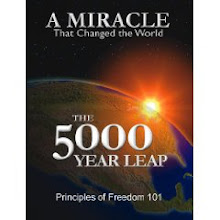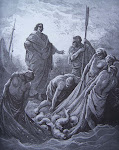
Believers in Messiah know that Yeshua (Jesus) has provided our atonement: “for all have sinned and come short of the glory of God; being justified freely by his grace through the redemption that is in Christ Jesus” (Rom. 3:23-24). God presented Him as a sacrifice of atonement, through faith in His blood. Yeshua's (Jesus') death surpasses and replaces the atonement ritual of the Jewish Temple. The book of Hebrews explains the ceremonies of the Day of Atonement as a pattern of the atoning work of Messiah. Yeshua (Jesus) is our high priest, and His blood shed on Calvary is seen as symbolized in the blood of bulls and goats. As the high priest of the Old Testament entered the Holy of Holies with the blood of his sacrificial victim, so Jesus entered heaven itself to appear before the Father on behalf of His people (Heb. 9:11-12) (Killian n.d.).
The Old Testament tabernacle was designed, in part, to teach Israel that sin hindered access to the presence of God. Only the high priest, and he only once a year, could enter the Holy of Holies, and then not without taking blood offered to atone for sins (Heb. 9:7). Hebrews notes that the levitical offerings could effect only the purification of the flesh. They ceremonially cleansed the sinner, but they could not bring about inward cleansing, the prerequisite for fellowship with God. Just as the high priest had to be sinless to enter the Holy of Holies and live, so Yeshua had to be sinless to live after He entered the grave.
But Messiah being come an high priest of good things to come, by a greater and more perfect tabernacle, not made with hands, that is to say, not of this building; Neither by the blood of goats and calves, but by his own blood he entered in once into the holy place, having obtained eternal redemption for us. For if the blood of bulls and of goats, and the ashes of an heifer sprinkling the unclean, sanctifieth to the purifying of the flesh: How much more shall the blood of Messiah, who through the eternal Spirit offered himself without spot to God, purge your conscience from dead works to serve the living God (Heb. 9:11-14).
The high priest had to offer sin offerings each year for his own sins and the sins of the people. This annual repetition of the sacrifices served as a reminder that perfect atonement had not yet been provided. Jesus, however, through His own blood effected eternal redemption for His people (Heb. 9:12).
The Old Testament offerings served as a pattern and a prophecy of Yeshua (Jesus), who, through His better sacrifice, cleanses the conscience from dead works (Heb. 9:13-14). God always determined what was an acceptable offering and what was not. He finally provided His Son, the Lamb of God, as the sacrifice for the sins of the world (John 1:19; 3:16). The moment Yeshua died, the veil of the temple was torn in two, from top to bottom (Matt. 27:50-51). The earth quaked beneath men’s feet. This event is important because it established Jesus as being the new High Priest and Lamb of God. No longer must there be an annual sacrifice for sin on our behalf; instead, He has made payment for us once and for all. Yeshua (Jesus), through a new and living way has entered heaven itself, the true Holy of Holies, where He ever lives to make intercession for His people. The believer need not stand afar off, as did the Israelite of old, but may now through Messiah approach the very Throne of Grace! Yes, it is now possible for each of us to have direct access to God through the blood of Yeshua HaMashiah (Jesus Christ)!
The Two Goats
After purifying the holy place and the altar of burnt offering with the mingled blood of the bullock, the High Priest went to the eastern side of the court in front of the Temple. Facing him were two identical goats. Nearby was a lottery box especially designed for this ceremony. In the box were two tablets (lots). One bore the name “For God,” the other “For azazel” (the scapegoat). The high priest shook the box and withdrew the tablets, putting one tablet in front of each goat. The goat labeled “for God” was sacrificed. The priest laid his hands upon the goat’s head labeled “for azazel” and confessed over it the sins of Israel. The scapegoat symbolically bore the sins of the nation of Israel away from the people. This goat, commonly called the scapegoat (i.e. escape goat), was then driven into the desert.In the same way Jesus was brought before Pilate and stood before the people just as He was about to be led forth, bearing the iniquities of the people. These two goats were required for one sacrifice (Lev 16:17, 21-22). Both sacrifices were fulfilled in the death and resurrection of Messiah Yeshua. How can resurrection be portrayed in a sacrifice? By using two animals, one killed, the other set free, representing Yeshua's (Jesus’) death and resurrection. And he shall take the two goats, and present them before the LORD at the door of the tabernacle of the congregation. And Aaron shall cast lots upon the two goats; one lot for the LORD, and the other lot for the scapegoat. And Aaron shall bring the goat upon which the LORD’S lot fell, and offer him for a sin offering. But the goat, on which the lot fell to be the scapegoat, shall be presented alive before the LORD, to make an atonement with him, and to let him go for a scapegoat into the wilderness (Lev. 16:7-10).
And he shall go out unto the altar that is before the LORD, and make an atonement for it; and shall take of the blood of the bullock, and of the blood of the goat, and put it upon the horns of the altar round about. And the goat shall bear upon him all their iniquities unto a land not inhabited: and he shall let go the goat in the wilderness (Lev. 16:18, 22).
.
Tradition states that a cord of red wool was tied on the horn of the scapegoat, before it was let go in the wilderness. When the red wool turned white, it was a sign that God forgave the people’s sin. Come now, and let us reason together, saith the LORD: though your sins be as scarlet, they shall be as white as snow; though they be red like crimson, they shall be as wool (Isa. 1:18).
The Priests used to bind a shining crimson strip of cloth on the outside door of the Temple. If the strip of cloth turned into the white color, they would rejoice; if it did not turn white they were full of sorrow and shame (Tractate Yoma 67a). Jewish literature explains the Shekhina glory of God left the Temple forty years prior to its destruction. Three signs occurred to show evidence of this:
.
1.) The western candle of the menorah refused to burn continually.
.
2.) The doors of the Temple would open of themselves.
.
3.) The red wool no longer turned white supernaturally.
.
This is especially significant because it indicated that God was no longer forgiving the sins of His people. The people were sorrowful because they began to realize more and more that the sacrifice of Yom Kippur did not have the power to cleanse their sinful hearts. That very year Messiah Jesus started His ministry, the very year that the blood of bulls and goats was no longer accepted as a sacrifice for the atonement of sin!
Prophetic Significance
The Second Coming or Judgment?
The entire ten days from the first day of the Feast of Trumpets through the Day of Atonement are known as Days of Repentance or Days of Awe. These days are possibly a picture of the Rapture (Feast of Trumpets), the Tribulation (days in between), and the second coming (Day of Atonement). Another theory claims these are a picture of the Second Coming (Feast of Trumpets), the Judgment (Day of Atonement). Second Coming?
Our Messiah made two promises before He returned to our Father. He would send the Comforter (Pentecost) and He would come again. And if I go and prepare a place for you, I will come again, and receive you unto myself; that where I am, there ye may be also (John 14:3). The Day of Atonement just may be the day of the Second Coming when Jesus will physically return to earth! The Bible clearly states Jesus will return immediately after the great tribulation. But in those days, after that tribulation, the sun shall be darkened, and the moon shall not give its light, and the stars will be falling from heaven, and the powers that are in the heavens will be shaken. And then they will see the Son of Man coming in clouds with great power and glory (Mark 13:24-26).
Day of Judgment?
The apostle Peter wrote about this awesome day of judgment. He declared, “But the day of the Lord will come like a thief. The heavens will disappear with a roar; the elements will be destroyed by fire, and the earth and everything in it will be laid bare. Since everything will be destroyed in this way, what kind of people ought you to be? You ought to live holy and godly lives as you look forward to the day of God and speed its coming.”
But the day of the Lord will come as a thief in the night; in the which the heavens shall pass away with a great noise, and the elements shall melt with fervent heat, the earth also and the works that are therein shall be burned up. Seeing then that all these things shall be dissolved, what manner of persons ought ye to be in all holy conversation and godliness, Looking for and hasting unto the coming of the day of God, wherein the heavens being on fire shall be dissolved, and the elements shall melt with fervent heat? Nevertheless we, according to his promise, look for new heavens and a new earth, wherein dwelleth righteousness (2 Peter 3:10-13).
When the Son of man shall come in his glory, and all the holy angels with him, then shall he sit upon the throne of his glory: And before him shall be gathered all nations: and he shall separate them one from another, as a shepherd divideth his sheep from the goats: And he shall set the sheep on his right hand, but the goats on the left. Then shall the King say unto them on his right hand, Come, ye blessed of my Father, inherit the kingdom prepared for you from the foundation of the world (Matt. 25:31-34).
For we must all appear before the judgment seat of Christ; that every one may receive the things done in his body, according to that he hath done, whether it be good or bad (2 Cor. 5:10).
In the coming judgment, there is forgiveness and mercy and grace to those who have already received Jesus Christ our Lord and Savior, Who gave His life as a ransom for us! Therefore being justified by faith, we have peace with God through our Lord Jesus Christ: By whom also we have access by faith into this grace wherein we stand, and rejoice in hope of the glory of God (Rom. 5:1-2).
.
Written by Robin Sampson
.
This article was well done and we wanted to share it with our readers. This article is from biblicalholidays.com. Please visit this insightful website for more insight into the Biblical Feast Days.















































